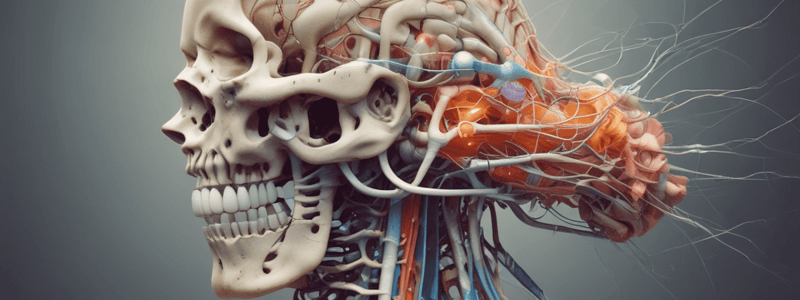Podcast
Questions and Answers
What movement is normally expected in response to stroking the outside sole from heel to toe with a pointed object?
What movement is normally expected in response to stroking the outside sole from heel to toe with a pointed object?
- Extension and abduction of all toes
- Plantar flexion of the ankle joint
- Upward movement of the big toe
- Downward movement of all toes (correct)
In which group of individuals would an upward (extensor) movement of the big toe, often with extension and abduction of the other toes, be most likely seen when the outside sole from heel to toe is stroked?
In which group of individuals would an upward (extensor) movement of the big toe, often with extension and abduction of the other toes, be most likely seen when the outside sole from heel to toe is stroked?
- Individuals with ankle injuries
- Adults with complete myelination
- Infants under 1.5 years of age (correct)
- Elderly individuals
What does tapping on the calcaneal tendon (Achilles Tendon) typically cause during the Achilles Reflex (Ankle Jerk Reflex)?
What does tapping on the calcaneal tendon (Achilles Tendon) typically cause during the Achilles Reflex (Ankle Jerk Reflex)?
- Adduction of the big toe
- Extension of the toes
- Dorsiflexion of the ankle joint
- Plantar flexion of the ankle joint (correct)
What does the Achilles Reflex assess for?
What does the Achilles Reflex assess for?
In which condition is the Achilles Reflex usually absent?
In which condition is the Achilles Reflex usually absent?
What is indicated by a reduction in the Achilles Reflex?
What is indicated by a reduction in the Achilles Reflex?
Which movement of the toes can be suggestive of incomplete myelination in children or dysfunction in the corticospinal tract?
Which movement of the toes can be suggestive of incomplete myelination in children or dysfunction in the corticospinal tract?
Which nerve roots are checked when performing the Achilles Reflex?
Which nerve roots are checked when performing the Achilles Reflex?
What does an upward movement of the big toe along with extension and abduction of the other toes indicate?
What does an upward movement of the big toe along with extension and abduction of the other toes indicate?
In individuals with dysfunction in the corticospinal tract, what might be observed in response to stroking the outside sole?
In individuals with dysfunction in the corticospinal tract, what might be observed in response to stroking the outside sole?
Flashcards are hidden until you start studying
Study Notes
Reflexes and Reflex Arcs
- Reflexes are fast, involuntary actions in response to stimuli, crucial for maintaining homeostasis.
- Reflexes can be classified as spinal or cranial, and can be somatic or autonomic (visceral).
- The gray matter of the spinal cord acts as an integrating center for spinal reflexes.
Reflex Arc Components
- A reflex arc is the pathway of nerve impulses that results in a reflex.
- Components of a reflex arc include:
- Receptor
- Sensory neuron
- Integrating center
- Motor neuron
- Effector
Types of Reflexes
- Somatic spinal reflexes involve voluntary skeletal muscle actions, while autonomic reflexes regulate involuntary bodily functions.
- Common somatic reflexes include:
- Stretch reflex
- Tendon reflex
- Flexor (withdrawal) reflex
- Crossed extensor reflex
- Reciprocal innervation occurs in all these reflexes, involving contraction of one muscle and relaxation of its antagonist.
Stretch Reflex (Patellar Reflex)
- A feedback mechanism that controls muscle length, promoting contraction when stretched to prevent injury.
- It is a monosynaptic, ipsilateral reflex arc, facilitating reciprocal innervation through interneurons.
Tendon Reflex
- Controls muscle tension by initiating relaxation when force is excessive, protecting both tendon and muscle.
- Involves Golgi tendon organs and is classified as an ipsilateral polysynaptic reflex.
- The reflex ensures the muscle relaxes when its tension reaches a critical level.
Flexor (Withdrawal) Reflex
- A protective reflex that causes limb withdrawal from painful stimuli, such as stepping on a tack.
- Involves ipsilateral activation, where flexor muscles contract to move the limb away from danger.
- Interneurons enable an intersegmental reflex, activating multiple muscle groups across different spinal segments.
Crossed Extensor Reflex
- A contralateral reflex that maintains balance during the flexor reflex by extending joints of one limb while flexing those of the opposite limb.
- For example, lifting the right foot involves extending the left leg for balance.
- Pain signals cross to the opposite side of the spinal cord, stimulating contralateral extensor muscles through interneuron activity.
Clinical Considerations
- Reflex testing can be crucial in identifying neurological disorders or injuries.
- Babinski's Reflex or Extensor Plantar Reflex is indicative of dysfunction in the corticospinal tract, associated with upper motor neuron lesions.
Studying That Suits You
Use AI to generate personalized quizzes and flashcards to suit your learning preferences.




